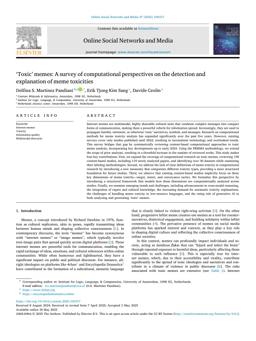2025-07-01
‘Toxic’ memes: A survey of computational perspectives on the detection and explanation of meme toxicities
Publication
Publication
Online Social Networks and Media , Volume 47 p. 100317:1- 100317:27
Internet memes are multimodal, highly shareable cultural units that condense complex messages into compact forms of communication, making them a powerful vehicle for information spread. Increasingly, they are used to propagate hateful, extremist, or otherwise ‘toxic’ narratives, symbols, and messages. Research on computational methods for meme toxicity analysis has expanded significantly over the past five years. However, existing surveys cover only studies published until 2022, resulting in inconsistent terminology and overlooked trends. This survey bridges that gap by systematically reviewing content-based computational approaches to toxic meme analysis, incorporating key developments up to early 2024. Using the PRISMA methodology, we extend the scope of prior analyses, resulting in a threefold increase in the number of reviewed works. This study makes four key contributions. First, we expand the coverage of computational research on toxic memes, reviewing 158 content-based studies, including 119 newly analyzed papers, and identifying over 30 datasets while examining their labeling methodologies. Second, we address the lack of clear definitions of meme toxicity in computational research by introducing a new taxonomy that categorizes different toxicity types, providing a more structured foundation for future studies. Third, we observe that existing content-based studies implicitly focus on three key dimensions of meme toxicity—target, intent, and conveyance tactics. We formalize this perspective by introducing a structured framework that models how these dimensions are computationally analyzed across studies. Finally, we examine emerging trends and challenges, including advancements in cross-modal reasoning, the integration of expert and cultural knowledge, the increasing demand for automatic toxicity explanations, the challenges of handling meme toxicity in low-resource languages, and the rising role of generative AI in both analyzing and generating ‘toxic’ memes.
| Additional Metadata | |
|---|---|
| , , , | |
| doi.org/10.1016/j.osnem.2025.100317 | |
| Online Social Networks and Media | |
| The eye of the beholder: Transparent pipelines for assessing online information quality , AI, Media & Democracy Lab | |
| , | |
| Organisation | Centrum Wiskunde & Informatica, Amsterdam (CWI), The Netherlands |
|
Martinez Pandiani, D., Tjong Kim Sang, E., & Ceolin, D. (2025). ‘Toxic’ memes: A survey of computational perspectives on the detection and explanation of meme toxicities. Online Social Networks and Media, 47, 100317:1–100317:27. doi:10.1016/j.osnem.2025.100317 |
|

